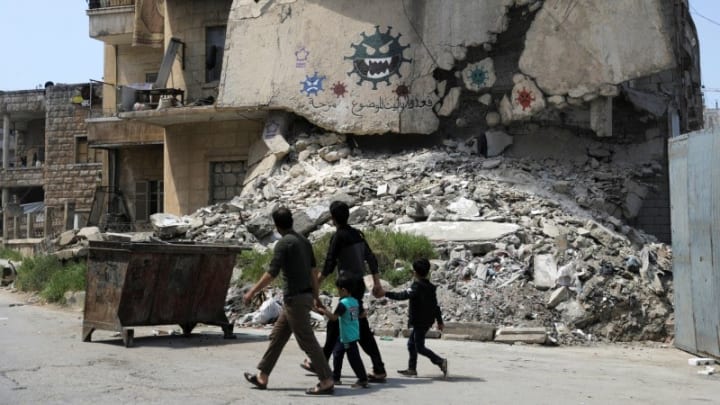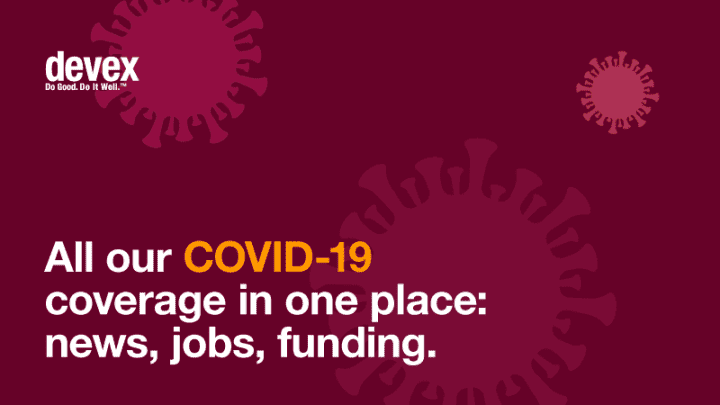
Mass COVID-19 vaccination campaigns in fragile and conflict settings remain months away, at the earliest, and an estimated 9 out of 10 people in low-income countries are unlikely to receive a vaccine this year, according to the People’s Vaccine Alliance.
But some international humanitarian and medical aid organizations are already bracing and preparing for the practical considerations of such a large undertaking, complicated by issues of ensuring access, combating misinformation, and contacting all eligible vaccine recipients.
“Especially in places that have protracted conflict, where there's also going to be weak governance, innately there's a mistrust or a distrust of information like this, on COVID-19 and vaccines, that comes out,” said Dee Goluba, director of field security at Mercy Corps. “We have never seen anything like this ever before: a massive global vaccination campaign. That takes the best of public health work to do right.”
‘Using all of our resources’
In northwestern Syria, the Syrian American Medical Society is coordinating with other local and international groups to set up 93 vaccination distribution centers in addition to mobile units, with the expectation that vaccines will become available through the World Health Organization in the second part of this year.
“It is a lot more challenging there than it would be in other parts of the world. We have had experience doing this, we have administered vaccines before, so we are using all of our resources so this campaign is efficient,” said Maher Azzouz, chairman at SAMS, which delivers 30% of health care in northwestern Syria.
Directly connecting with people who are eligible for the vaccine is one likely challenge, according to Azzouz, complicated by the fact that many of the 4.3 million people in the region do not have formal, state-issued identification. Tapping existing humanitarian registries that document aid recipients one way to navigate this problem, Azzouz said. On-the-spot registration is another way forward.
“The main factor now is access and making sure the most vulnerable are reached, knowing we have limited resources. The quicker we get it into the arms of people, the more people get it, the more benefit we get. But it is a big undertaking,” Azzouz continued.
These adapted methods, though, won’t negate other challenges, such as ensuring people return within three to four weeks of their initial vaccine for a booster, as manufacturers recommend.
“Conflict zones can’t enjoy this luxury. We might have to be a little bit flexible with the timing of the second dose. Weighing the risks and balances is part of the operation,” Azzouz said.
“We're worried that that uneven distribution of vaccines could actually spark new grievances.”
— Anissa Toscano, vice president of humanitarian leadership and response, Mercy CorpsUnderstanding who is likely to get left behind
On Friday, the COVAX vaccine facility announced a new agreement with Pfizer for 40 million doses of its vaccine and also confirmed plans to receive 100 million doses of the vaccine produced by AstraZeneca and the University of Oxford. The majority of the first 100 million doses are earmarked for delivery to low- and middle-income countries in the first part of the year, according to UNICEF. Despite funding shortfalls, COVAX aims to deliver 2 billion vaccines in 2021.
But governments would be tasked with deciding which people receive priority for vaccination. That will likely push migrants, refugees, and unregistered people to the bottom of the list, according to Anissa Toscano, vice president of humanitarian leadership and response at Mercy Corps. Colombian President Iván Duque announced at the end of December that Venezuelans without formal migratory status would not get access to COVID-19 vaccines.
Get development's most important headlines in your inbox every day.
Thanks for subscribing!
“We're worried that that uneven distribution of vaccines could actually spark new grievances,” Toscano said. “We need the global community to really engage on this issue of who will potentially be left behind.”
The Inter-Agency Standing Committee is holding talks on the establishment of a COVAX humanitarian “buffer,” which would ensure that up to 5% of COVID-19 vaccines procured by the facility are stored for the most at-risk populations. No decisions have yet been finalized on this plan, according to John Johnson, project lead for vaccination at Médecins Sans Frontières in France.
Weighing risks and benefits
There are some lessons from other large-scale vaccine campaigns in conflict settings that can be applied to the upcoming COVID-19 vaccine mission.
The spread of Ebola from 2018 through 2020 in the province of North Kivu in the Democratic Republic of the Congo, for example, was the first such outbreak in a conflict zone, according to Johnson. The logistics of access and contact tracing were especially challenging, Johnson said, and it remains unclear exactly how effective the vaccination campaign truly was.
Opinion: Without urgent action, billions will miss out on a COVID-19 vaccine this year
Mesfin Teklu Tessema, senior director of health at the International Rescue Committee, urges the Biden administration to commit $20 billion in aid to fight COVID-19 globally.
MSF helped deploy a “ring strategy,” also used with smallpox, which involves vaccinating direct contacts of people infected with Ebola. The goal was to vaccinate 150 to 200 people for every Ebola case — but an estimated 88 people per case were eventually reached in the North Kivu region. MSF also trained local partners on public health measures such as safe burial practices, and these partners went in and out of active conflict areas.
“We weren't finding enough contacts; people were disappearing. In theory, it is an effective strategy to wipe this out,” Johnson said. “The outbreak went on for two years. [The vaccination strategy] clearly wasn’t working very well, but it wasn't implemented perfectly. At the same time, it probably makes a huge difference. We just don't know how many cases were avoided,” Johnson said.
MSF is now in talks with different governments about assisting with COVID-19 vaccination rollouts. Johnson noted, though, that vaccine campaigns are typically not carried out readily in active conflict settings, given the increased risks to health care providers and civilians alike.
“When you think about vaccination, it is different from thinking about treating sick people. When you are treating well people with vaccines in conflict settings, you take a lot less risk. The risk you take to vaccinate people, or the risk they take to get vaccinated, needs to be weighed against the benefit of getting vaccinated,” Johnson said.
But in places such as Syria, where conflict has dragged on for nearly 10 years, this risk calculation might not easily apply, Azzouz said.
“After 10 years, we are still guided by the definition of emergency response. It cannot just be emergency needs, whether health or humanitarian,” Azzouz said. “This is a pandemic, and the international community early on declared vaccinations as part of any emergency response. This is not secondary or tertiary care. This is essential care, and no different from other vaccine campaigns that are run.”

Printing articles to share with others is a breach of our terms and conditions and copyright policy. Please use the sharing options on the left side of the article. Devex Pro subscribers may share up to 10 articles per month using the Pro share tool ( ).
"conflict" - Google News
January 25, 2021 at 05:52PM
https://ift.tt/39g5ule
Humanitarians plan for COVID-19 vaccinations in conflict zones - Devex
"conflict" - Google News
https://ift.tt/3bZ36xX
https://ift.tt/3aYn0I8
Bagikan Berita Ini














0 Response to "Humanitarians plan for COVID-19 vaccinations in conflict zones - Devex"
Post a Comment